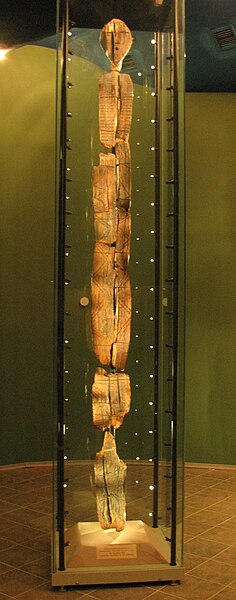The Shigir Sculpture, or Shigir Idol, is the oldest known wooden sculpture. It was carved during the Mesolithic period, shortly after the end of the last Ice Age, and is twice as old as Egypt's Great Pyramid. The wood it was carved from is approximately 12,000 years old.
The sculpture, dated to 11,500 years ago, may have stood more than 5 m (16 ft) high
The "small" Shigir Idol.
Some of the lower faces on the sculpture are visible in this image
The Mesolithic or Middle Stone Age is the Old World archaeological period between the Upper Paleolithic and the Neolithic. The term Epipaleolithic is often used synonymously, especially for outside northern Europe, and for the corresponding period in the Levant and Caucasus. The Mesolithic has different time spans in different parts of Eurasia. It refers to the final period of hunter-gatherer cultures in Europe and the Middle East, between the end of the Last Glacial Maximum and the Neolithic Revolution. In Europe it spans roughly 15,000 to 5,000 BP; in the Middle East roughly 20,000 to 10,000 BP. The term is less used of areas farther east, and not at all beyond Eurasia and North Africa.
Reconstruction of a "temporary" Mesolithic house in Ireland; waterside sites offered good food resources.
The Mesolithic begins during the latest Pleistocene, characterized by a progressive rise of temperatures, between the end of the Last Glacial Maximum and the Neolithic Revolution during the Holocene. Evolution of temperature in the Post-Glacial period according to Greenland ice cores.
Mesolithic artifacts
The Shigir Idol, from the east of the Ural mountains.






